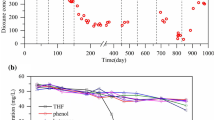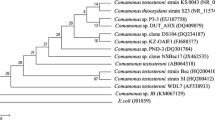Abstract
The purpose of this work was to investigate the anaerobic transformation ofo-xylene in a laboratory biofilm system with nitrate as an electron acceptor.o-Xylene was degraded cometabolically with toluene as primary carbon source. A mass balance showed thato-xylene was not mineralized but transformed.o-Methyl-benzalcohol ando-methyl-benzaldehyde were identified as intermediates ofo-xylene transformation which resulted in the formation ofo-methyl-benzoic acid as an end product. A cross inhibition phenomenon was observed between toluene ando-xylene. The presence of toluene was necessary for stimulation ofo-xylene transformation, but above a toluene concentration of 1–3 mg/L theo-xylene removal rate dramatically decreased. In returno-xylene inhibited the toluene degradation at concentrations above 2–3 mg/L.
Similar content being viewed by others
References
APHA (1989) Standard Methods for the Examination of Water and Wastewater, 17th Edition. American Public Health Association, Washington, DC
Arcangeli JP & Arvin E (1993a) Kinetics of toluene degradation in a biofilm reactor under denitrifying conditions. Accepted for presentation at the 2nd International Specialized Conference on Biofilm Reactors, IAWQ, Paris, France, September 29 – October 1, 1993
Arcangeli JP & Arvin E (1993b) Modelling ofo-xylene cometabolic transformation in a biofilm reactor under denitrifying conditions. Biodeg. 6: 27–36 (this issue)
Barbaro JR, Baker JF, Lemon LA & Mayfield CI (1992) Biotransformation of BTEX under anaerobic, denitrifying condition: field and laboratory observations. J. Contam. Hydrol. 11: 245–272
Broholm K, Christensen TH & Jensen BK (1992) Modelling TCE degradation by a mixed culture of methane-oxidizing bacteria. Wat. Res. 26: 1177–1185
Chang MK, Voice CV & Criddle CS (1993) Kinetics of competitive inhibition and cometabolism in the biodegradation of benzene, toluene, andp-xylene by twoPseudomonas isolates. Biotech. Bioengineer. 41: 1057–1065
Evans PJ, Mang DT, Kim KS & Young LY (1991) Anaerobic degradation of toluene by a denitrifying bacterium. Appl. Environ. Microbiol. 57: 1139–1145
Evans PJ, Ling W, Goldschmidt B, Ritter ER & Young LY (1992) Metabolites formed during anaerobic transformation of toluene ando-xylene and their proposed relationship to the initial steps of toluene mineralization. Appl. Environ. Microbiol. 58: 496–501
Harremoës P (1978) Biofilm kinetics. In: Mitchell R (Ed) Water Pollution Microbiology, Vol 2 (pp 82–109). John Wiley, New York
Higson FK & Focht DD (1992) Degradation of 2-methylbenzoic acid byPseudomonas cepacia MB2. Appl. Environ. Microbiol. 58: 194–200
Hutchins SR & Wilson JT (1991) Laboratory and field studies on BTEX biodegradation in a fuel-contaminated aquifer under denitrifying condition. In: Hinchee RE & Olfenbuttel RF (Eds)In Situ Bioreclamation. Applications and Investigations for Hydrocarbon and Contaminated Site (pp 157–172). Butterworth-Heineman, Stoneham, MA
Jensen HM (1992) Kinetic of toluene and benzene biodegradation. Statistical analysis. Master Thesis Report (In Danish). The Institute of Mathematical Statistics and Operations Research, The Technical University of Denmark, DK 2800 Lyngby, Denmark
Jensen BK, Arvin E & Gundersen AT (1988) Biodegradation of phenolic and monoaromatic hydrocarbons by a mixed wastewater culture under denitrifying conditions. Presented at Cost 691/681 Workshop on Organic Contaminants in Wastewater, Sludge & Sediments: Occurrence, Fate and Disposal, Brussels, Oct. 26–27, 1988
Jørgensen C (1992) Anaerobic microbial degradation of aromatic hydrocarbons. Ph.D. Thesis. Department of Environmental Engineering, The Technical University of Denmark, DK 2800 Lyngby, Denmark
Kamphake LJ, Hannah SA & Cohen JM (1967) Automated analysis for nitrate by hydrazine reduction. Wat. Res. 1:205–216
Kjeldsen P (1992) Evaluation of gas diffusion through plastic materials used in experimental and sampling equipment. Wat. Res. 27: 121–131
Kristensen GH & Jansen JLC (1980) Fixed Film Kineties. Description of Laboratory Equipment. Department of Environmental Engineering, Technical University of Denmark, DK 2800 Lyngby, Denmark
Londry KL & Fedorak PM (1992) Anaerobic degradation of 2-methylbenzoic acid by a methanogenic consortium. Submitted to Can. J. Microbiol.
Roberts DJ, Fedorak PM & Hrudey SE (1990) CO2 Incorporation and 4-Hydroxy-2-Methylbenzoic Acid Formation during Anaerobic Metabolism ofm-Cresol by a Methanogenic Consortium. Appl. Environ. Microbiol. 56: 472–478
Semprini L, Hopkins GD, Roberts PV, Grbic-Galic D & McCarty PL (1991) A field evaluation ofin-situ biodegradation of chlorinated ethenes: Part 3, Studies of competitive inhibition. Ground Water 29: 239–250
Zeyer J, Kuhn EP & Schwarzenbach RP (1986) Rapid microbial mineralization of toluene and 1,3-dimethylbenzene in the absence of molecular oxygen. Appl. Environ. Microbiol. 52: 944–947
Author information
Authors and Affiliations
Rights and permissions
About this article
Cite this article
Arcangeli, JP., Arvin, E. Cometabolic transformation ofo-xylene in a biofilm system under nitrate reducing conditions. Biodegradation 6, 19–27 (1995). https://doi.org/10.1007/BF00702295
Received:
Accepted:
Issue Date:
DOI: https://doi.org/10.1007/BF00702295




